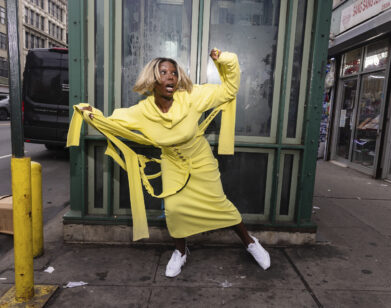Belleville Is Burning: You and Now at Balice Hertling

INSTALLATION IMAGE COURTESY BALICE HERTLING
PHOTO BY GUILLAUME ZICCARELLI
Belleville, not to be confused with Bellevue, in Paris’s 20th and final arrondissement, is in the midst of a long-standing awakening. It’s also an awakening for the French art scene, French artists and a growing number of expats working here. One catches a whiff of cheap rents and smart galleries tucking into every nook and cranny up in the 20th.
Balice Hertling, founded by Daniele Balice and Alexander Hertling, is one of the neighborhood’s newcomers—Balice and Hertling moved their gallery to an expanded Belleville space last year. “You And Now,” the current show by guest curator Hannes Hetta, which opened there Wednesday, dishes up several views of artful deconstruction/reconstruction from Tauba Auerbach, Oscar Tuazon, Sebastian Wickeroth, Collier Schorr, Genesis Breyer P-Orridge and Camilla LØW, with a performance from inimitable Norwegian songbird Nils Bech.
The classically trained Bech performed his “Curious Love” pushing his voice into all sorts of uneasy places, with a cracked fragility, while wobbling precariously atop a high ladder, before quickly disappearing into the gallery’s broom closet. He came back to sing his breakthrough hit “Look Back” (released on Fysisk Format in Norway, an album written and performed in close collaboration with sax-virtuoso and producer Bendik Giske) as he seemed to bounce off the gallery’s white walls.
This is the first show Hetta has curated. A fashion editor at Vogue Hommes, he’s always been moving around the art world as what he calls a “visual consumer.” “The show was a long process which began over a year ago,” says Hetta. “The possibilities were endless because there were no obligations. All the works deal with destruction and reconstruction. But I don’t look at this in a negative way. I see the future brightly.” Crushed, crashed and seemingly heading for the breaking point, the works in “You And Now” are focused on the moments just before or after one realizes the machine has jammed, the box has dropped and the glass has shattered. Adjust your view for a moment and you see that broken is beautiful, and maybe we can just slap a Band-Aid on life’s various faults and limp along anyway. The purpose of destruction is to transform a system, object or situation into something else, Hetta says. “You see random patterns and then possibilities emerge between the cracks.” LEFT: DANIELE BALICE AND ALEXANDER HERTLING. PHOTO BY BERNARD MEL
Tauba Auerbach’s Shatter IV (2010), part of a series the artist began in 2008, is a kaleidoscopic view of a break-up: In this case, a sheet of glass placed between a wooden panel and a piece of cardboard that she cracks with one swing, and then painstakingly colors in, shard by shard. While Auerbach used broken glass as a framework, Sebastian Wickeroth carefully constructed his “Strategie der Steine,” 2010 crash scene, from scratch. As Tobias Hoffman wrote in his essay on the Düsseldorf artist, Wickeroth “doesn’t cause destruction, he constructs destruction.” His magnificently exploded shiny gray cardboard box at Balice Hertling seems to have lost its slick geometric finish, and the only thing missing is the bang, because however realistic the impression of destruction, there was no impact.
“There’s been a lot of talk about today’s saturated society, and it seems like there hasn’t been much progression culturally during this decade,” says Hetta. “I think things could change dramatically soon, and one way to look at change is through destruction and chaos.”
Camilla LØW’s “Shotgun and Petrol,” 2010, two metal grids which look like fluffy clouds have punched holes through them, didn’t arrive for the opening. And in a way, it’s the most mysterious work in the show. How could something so soft punch through metal like that?
Oscar Tuazon’s DIY architectural sculpture is usually on the gigantic side, a collection of rough-hewn beams leaning on gallery walls or punching holes through them for support. These works give an aggressive, invasive impression like a building within a building, or a squatter who has tacked together a makeshift home inside a totally incongruous space. So it was a surprise to see two small pieces from Tuazon, which are more a celebration of decrepit materials. His “Octet Truss” (Repaired and Reinforced), 2008, a collection of rusty metal cubes strung together with thin wire, and his untitled, 2010 column of smashed mirror, glass and Plexiglas plastered with paint and silicone look elegantly destitute.
In the midst of this destruction derby, Collier Schorr’s floral Arrangement series set up in the sunny mountainside of Schwäbisch Gmünd, the small town in southern Germany where the family of her friend Monika Condrea lives, seems positively pastoral. That is the first impression. The bright flowers floating in mid air are actually strung up, trapped in a tangled web, supported by twigs and sure to quickly wilt in the sunny paradise.
All of this seems like a prelude to Genesis Breyer P-Orridge’s hypnotic collage “Origin Ov Thee Species,” 1998. “I’ve been a major fan of hers for a long time,” says Hetta. “She’s one of the most progressive people in the world today. She and Lady Jaye, who passed away five or six years ago, started the Pandrogyny project, which I think is one of the most beautiful manifestations of love between two people. ” Using plastic surgery, the two sought to morph into each other to become a unity, one intersected sex. The collage, a column-like repeat of intersecting bottoms, is “a bit like heaven and hell,” says Hetta and “a perfect example of this kind of limbo state when everything is chaotic and you can see a real possibility of reconstruction.”
YOU AND NOW RUNS THROUGH FEBRUARY 5, 2011 AT BALICE HERTLING, 47 RUE RAMPONEAU, 75020 PARIS, FRANCE.






